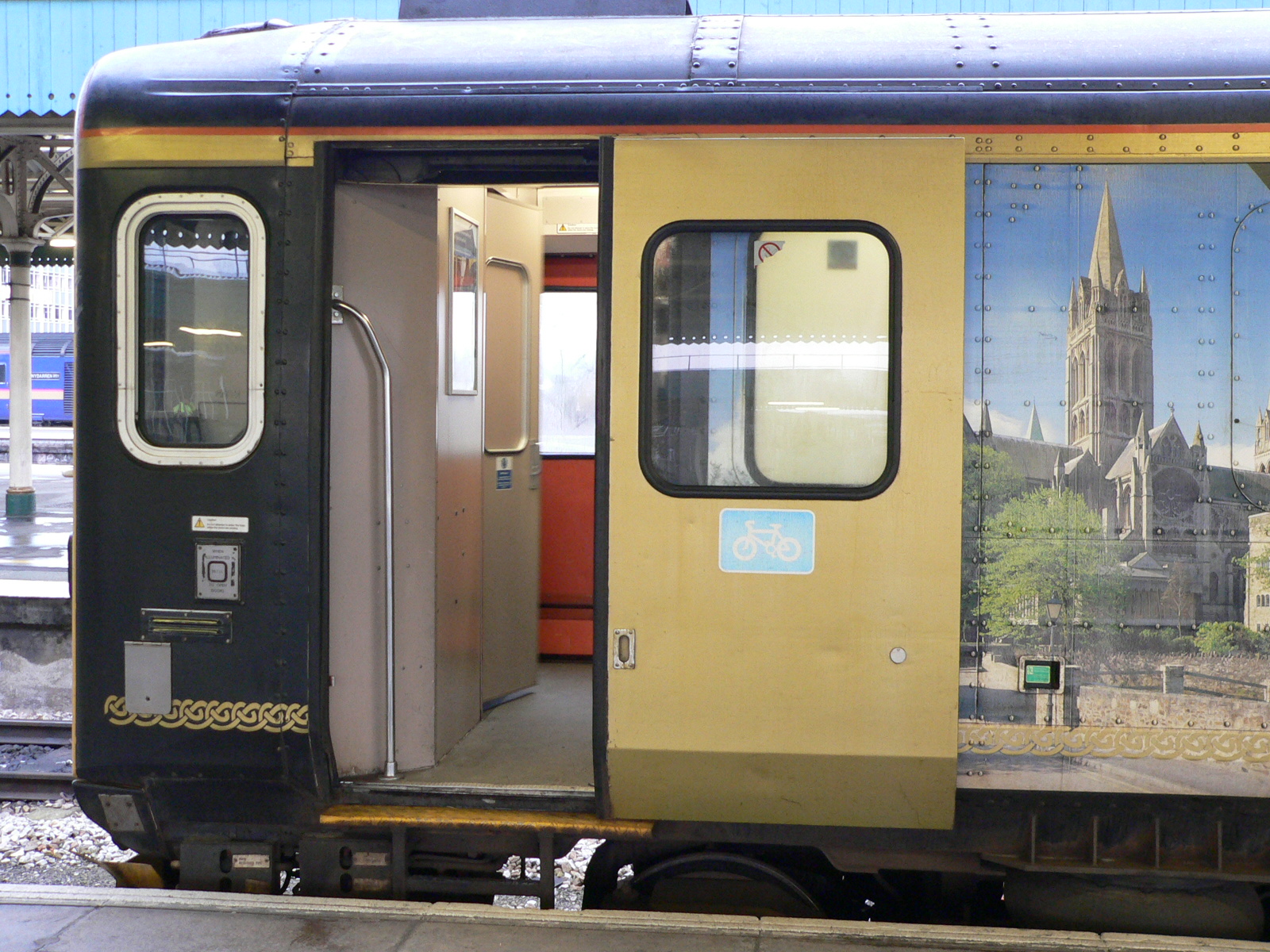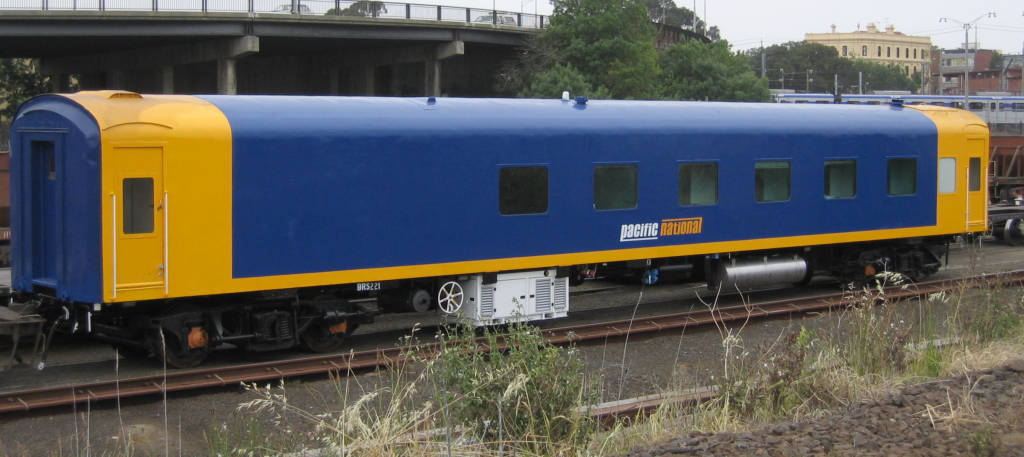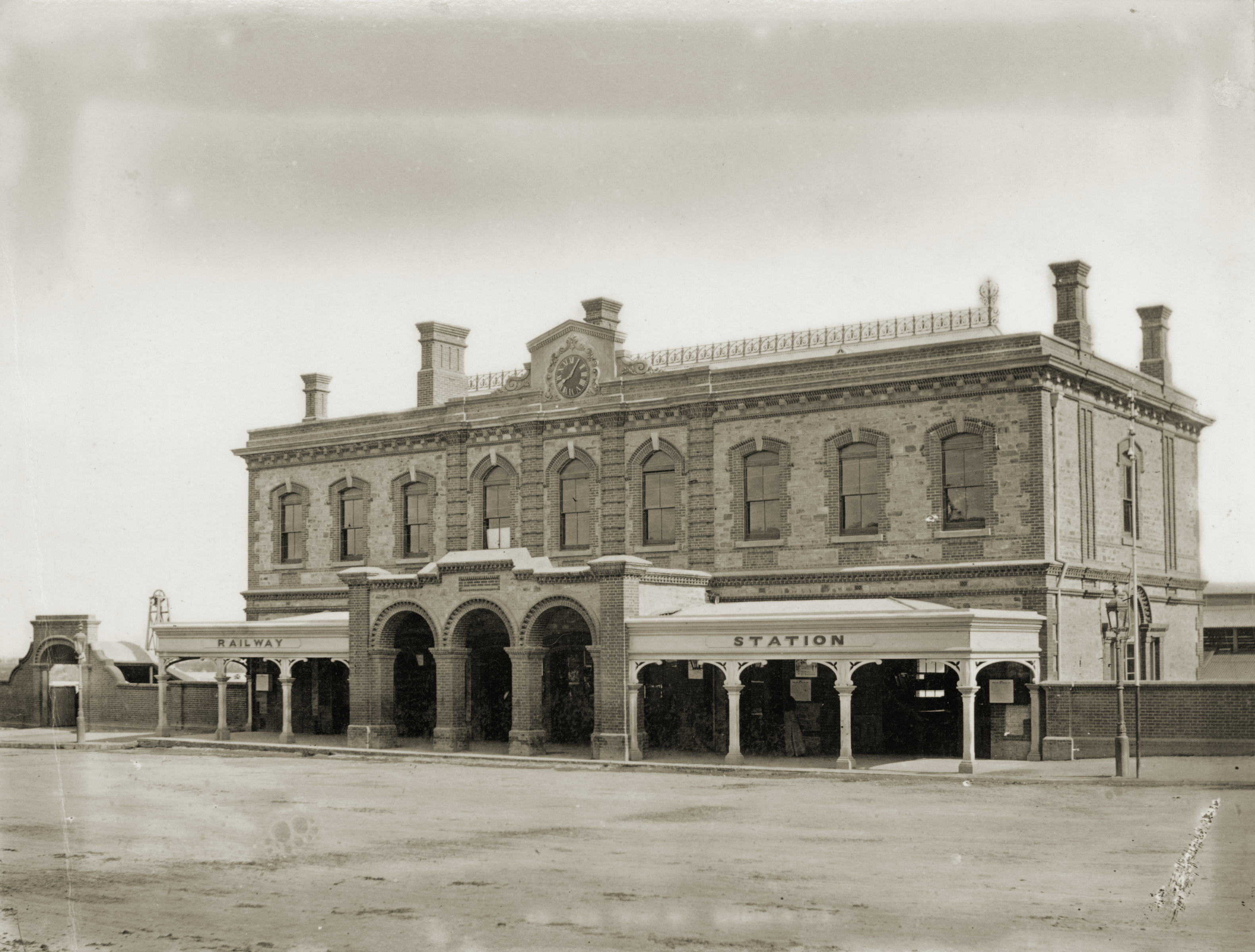|
V Type Carriage
The V type carriages, introduced from 1897, were the first group of Victorian Railways passenger rolling stock to have their own distinct class. Despite some records, these classes were never "doubled" to reflect their bogies; for example, the class AVAV never existed. AV In the closing years of the 19th century, the Victorian Railways found itself in need of more passenger carriages. In 1897, a design was settled upon, and carriage AV285 was constructed and brought into use. The number 285 was a follow-on from the AA class of carriages, the last of those having been numbered 284. The "V" indicated that the carriage was of a vestibule design, with a walk-through connection to the next carriage. The new carriage was long, and the internal layout was similar to the later E, W and S carriages, having compartments with a side corridor. It was the first passenger carriage to include toilets, which were becoming more important, given the longer journeys that could be undertaken ... [...More Info...] [...Related Items...] OR: [Wikipedia] [Google] [Baidu] |
Victorian Railways
The Victorian Railways (VR), trading from 1974 as VicRail, was the state-owned operator of most rail transport in the Australian state of Victoria from 1859 to 1983. The first railways in Victoria were private companies, but when these companies failed or defaulted, the Victorian Railways was established to take over their operations. Most of the lines operated by the Victorian Railways were of . However, the railways also operated up to five narrow gauge lines between 1898 and 1962, and a line between Albury and Melbourne from 1961. History Formation A Department of Railways was created in 1856 with the first appointment of staff. British engineer, George Christian Darbyshire was made first Engineer-in-Chief in 1857, and steered all railway construction work until his replacement by Thomas Higginbotham in 1860. In late 1876, New York consulting engineer Walton Evans arranged the supply of two 4-4-0 locomotives manufactured by the Rogers Locomotive Works of New Jersey, US ... [...More Info...] [...Related Items...] OR: [Wikipedia] [Google] [Baidu] |
AA Class
AA, Aa, Double A, or Double-A may refer to: Arts, entertainment and media * '' America's Army'', a 2002 computer game published by the U.S. Army * ''Ancient Anguish'', a computer game in existence since 1992 * Aa!, a J-Pop musical group * Double-A (band), stylised as AA, South Korean boy band * ''Aa'' (album), a 2016 album by Baauer * AA (song), a 2021 single by Walker Hayes * Ace Attorney, a series of video games developed by Capcom. * AA Films, an Indian film distribution company *AA Book (other) *AA, the production code for the 1966 ''Doctor Who'' serial '' The Savages'' Brands, organizations and enterprises * Alcoholics Anonymous, an international fellowship dedicated to helping alcoholics peer to peer in sobriety * A. A. Arms, a defunct firearms manufacturer * Aerolíneas Argentinas, an Argentine airline (logo used to consist of two A's) * Air Asia, an Asian multinational low cost carrier * Alcoa, an American aluminum-producing company (stock symbol AA) * Am ... [...More Info...] [...Related Items...] OR: [Wikipedia] [Google] [Baidu] |
Vestibuled Train
A vestibuled train is a passenger train whose cars have enclosed vestibules at their ends, in contrast to the open platforms on early cars. Typically, a vestibule has doorways on either side to allow passenger entry and exit at stations, a door into the body of the car, and, at the car end, a doorway to allow access to the next car through a flexible gangway connection. History The first vestibuled train was introduced on June 15, 1887, on the inaugural run of the ''Pennsylvania Limited'' of the Pennsylvania Railroad, forerunner of the famous ''Broadway Limited''. The railway car vestibule as a concept had been tried in various primitive forms during the latter part of the 19th century, but the first viable form was invented by H. H. Sessions and his staff at the Pullman Car Works in Chicago. Sessions' patent was challenged by others and reduced in litigation to the spring mechanism of his vestibule design. Further litigation by Pullman was successful in modifying the earli ... [...More Info...] [...Related Items...] OR: [Wikipedia] [Google] [Baidu] |
Victorian Railways E Type Carriage
The E type carriages were wooden express passenger carriage used on the railways of Victoria, Australia. Originally introduced by Victorian Railways Chairman of Commissioners Thomas James Tait for the interstate service between Melbourne, Sydney and Adelaide, these Canadian-inspired carriages remained in regular service for 85 years over the entire Victorian network. Design Carriages on Victorian long-distance express services at the start of the 20th century were, in comparison to the Pullman cars operated by the New South Wales Government Railways, relatively cramped and austere. Chairman of Commissioners Thomas Tait, previously the Transportation Manager of the Canadian Pacific Railway, introduced a carriage design that was long, and as wide as the loading gauge allowed. Much of their external appearance was based on typical Canadian carriage design, with a clerestory roof curved at the ends, doors only at the ends of the car, and six-wheel bogies, although their interio ... [...More Info...] [...Related Items...] OR: [Wikipedia] [Google] [Baidu] |
Victorian Railways Short W Type Carriage
The W type carriages were wooden passenger carriages used on the railways of Victoria, Australia. There were two variants, short- and long-body vehicles, and this article deals with the former. Details on the latter can be found here. History In the early 20th century, the Victorian Railways decided to convert the metropolitan part of the network to electric traction. As part of that project, a large number of "Swing Door" ("dog box") cars were converted to electric traction, which left a gaping hole in the carriage fleet. As a result, the 'W' series of passenger cars was built. Four variations were constructed from 1911 onwards: AW, ABW, BW and CW. The origin of the 'W' designation is unclear. In most other cases the class letter was derived from a basic feature of the car type, or its use. In the 1900s, new express passenger cars, designated 'E', were being built to replace ageing equipment. The W-class cars were of a similar design but modified for general stopping trains. ... [...More Info...] [...Related Items...] OR: [Wikipedia] [Google] [Baidu] |
Victorian Railways S Type Carriage
The S type carriages are a corridor-type passenger carriage used on the railways of Victoria, Australia. The first carriages were constructed by the Victorian Railways in 1937 for use on the ''Spirit of Progress'', with additional carriages built for other trains until the mid-1950s. Introduced by Victorian Railways Chairman of Commissioners Harold Clapp for the ''Spirit of Progress'' service between Melbourne and Albury, the carriages lasted through many decades of regular service, with more than one operator. Two major variants of the S-type carriage were constructed: AS first-class cars with 3+3 seating in each compartment, and BS second-class cars with 4+4 seating. A handful of other cars were constructed for various specialist purposes. A number of conversions were carried out in later years, with the addition of beds to some to create sleeping cars, and buffet modules fitted to others to provide on-board catering facilities. The BRS buffet cars were the most recent co ... [...More Info...] [...Related Items...] OR: [Wikipedia] [Google] [Baidu] |
Southern Cross Railway Station
Southern Cross railway station (until 2005 known as Spencer Street station) is a major railway station in Docklands, Victoria, Docklands, Melbourne. It is on Spencer Street, Melbourne, Spencer Street, between Collins Street, Melbourne, Collins and La Trobe Street, Melbourne, La Trobe Streets, at the western edge of the Melbourne city centre, Melbourne central business district. The Docklands Stadium sports arena is 500 metres north-west of the station. The station is owned, operated and maintained by Civic Nexus, a subsidiary of IFM Investors and operating as Southern Cross Station Pty Ltd, under a 30-year lease to 2036 from the Victorian State Government, as part of a public-private partnership. Southern Cross Station Pty Ltd contracts Infranexus Management Pty Ltd (Infranexus) for management services. Infranexus is also wholly owned by IFM. The station is the terminus of the List of regional railway stations in Victoria, state's regional railway network operated by V/Line, ' ... [...More Info...] [...Related Items...] OR: [Wikipedia] [Google] [Baidu] |
Adelaide Railway Station
Adelaide Railway Station is the central terminus of the Adelaide Metro railway system. All lines approach the station from the west, and it is a terminal station with no through lines, with most of the traffic on the metropolitan network either departing or terminating here. It has nine platforms, all using broad gauge track. It is located on the north side of North Terrace, west of Parliament House. The Adelaide Casino occupies part of the building that is no longer required for railway use. Until 1984, Adelaide station was also the terminus for regional and interstate passenger trains, but there are no longer any regular regional train services in South Australia, and all interstate services are now handled at Adelaide Parklands Terminal. History Early growth Adelaide's first railway station opened on the current North Terrace site in 1856. It served the broad gauge line between Adelaide and Port Adelaide, which was the first government-owned and operated steam railwa ... [...More Info...] [...Related Items...] OR: [Wikipedia] [Google] [Baidu] |
Newport Workshops
The Newport Railway Workshops is a facility in the Melbourne suburb of Newport, Victoria, Newport, Australia, that builds, maintains and refurbishes Rolling stock, railway rollingstock. It is located between the Williamstown railway line, Williamstown and Werribee railway lines. History Plans for a workshop at Newport started in the 1860s, to replace the temporary Williamstown Workshops but nothing came of it. It was not until 1880 that work began, when the Victorian Railways purchased annexes used at the Melbourne International Exhibition (1880), 1880 Melbourne Exhibition and erected one of them at Newport, naming it the Newport Carriage Workshops when it began operation in 1882. Construction of the permanent workshops commenced in 1884, and was completed in 1889. Although the earlier carriage workshop closed at this time, it reopened in 1895 to manufacture signal equipment. The first Railroad car, carriages built by the workshops were completed in 1889, but locomotives were ma ... [...More Info...] [...Related Items...] OR: [Wikipedia] [Google] [Baidu] |
Heritage Railway
A heritage railway or heritage railroad (US usage) is a railway operated as living history to re-create or preserve railway scenes of the past. Heritage railways are often old railway lines preserved in a state depicting a period (or periods) in the history of rail transport. Definition The British Office of Rail and Road defines heritage railways as follows:...'lines of local interest', museum railways or tourist railways that have retained or assumed the character and appearance and operating practices of railways of former times. Several lines that operate in isolation provide genuine transport facilities, providing community links. Most lines constitute tourist or educational attractions in their own right. Much of the rolling stock and other equipment used on these systems is original and is of historic value in its own right. Many systems aim to replicate both the look and operating practices of historic former railways companies. Infrastructure Heritage railway lines ... [...More Info...] [...Related Items...] OR: [Wikipedia] [Google] [Baidu] |
Victorian Railways Bogie Types
Victorian or Victorians may refer to: 19th century * Victorian era, British history during Queen Victoria's 19th-century reign ** Victorian architecture ** Victorian house ** Victorian decorative arts ** Victorian fashion ** Victorian literature ** Victorian morality ** Victoriana Other * ''The Victorians'', a 2009 British documentary * Victorian, a resident of the state of Victoria, Australia * Victorian, a resident of the provincial capital city of Victoria, British Columbia, Canada * RMS ''Victorian'', a ship * Saint Victorian (other), various saints * Victorian (horse) * Victorian Football Club (other), either of two defunct Australian rules football clubs See also * Neo-Victorian, a late 20th century aesthetic movement * Queen Victoria * Victoria (other) Victoria most commonly refers to: * Victoria (Australia), a state of the Commonwealth of Australia * Victoria, British Columbia, provincial capital of British Columbia, Canada * Victoria ( ... [...More Info...] [...Related Items...] OR: [Wikipedia] [Google] [Baidu] |
E Type Carriage
The E type carriages were wooden express passenger carriage used on the railways of Victoria, Australia. Originally introduced by Victorian Railways Chairman of Commissioners Thomas James Tait for the interstate service between Melbourne, Sydney and Adelaide, these Canadian-inspired carriages remained in regular service for 85 years over the entire Victorian network. Design Carriages on Victorian long-distance express services at the start of the 20th century were, in comparison to the Pullman cars operated by the New South Wales Government Railways, relatively cramped and austere. Chairman of Commissioners Thomas Tait, previously the Transportation Manager of the Canadian Pacific Railway, introduced a carriage design that was long, and as wide as the loading gauge allowed. Much of their external appearance was based on typical Canadian carriage design, with a clerestory roof curved at the ends, doors only at the ends of the car, and six-wheel bogies, although their inte ... [...More Info...] [...Related Items...] OR: [Wikipedia] [Google] [Baidu] |









